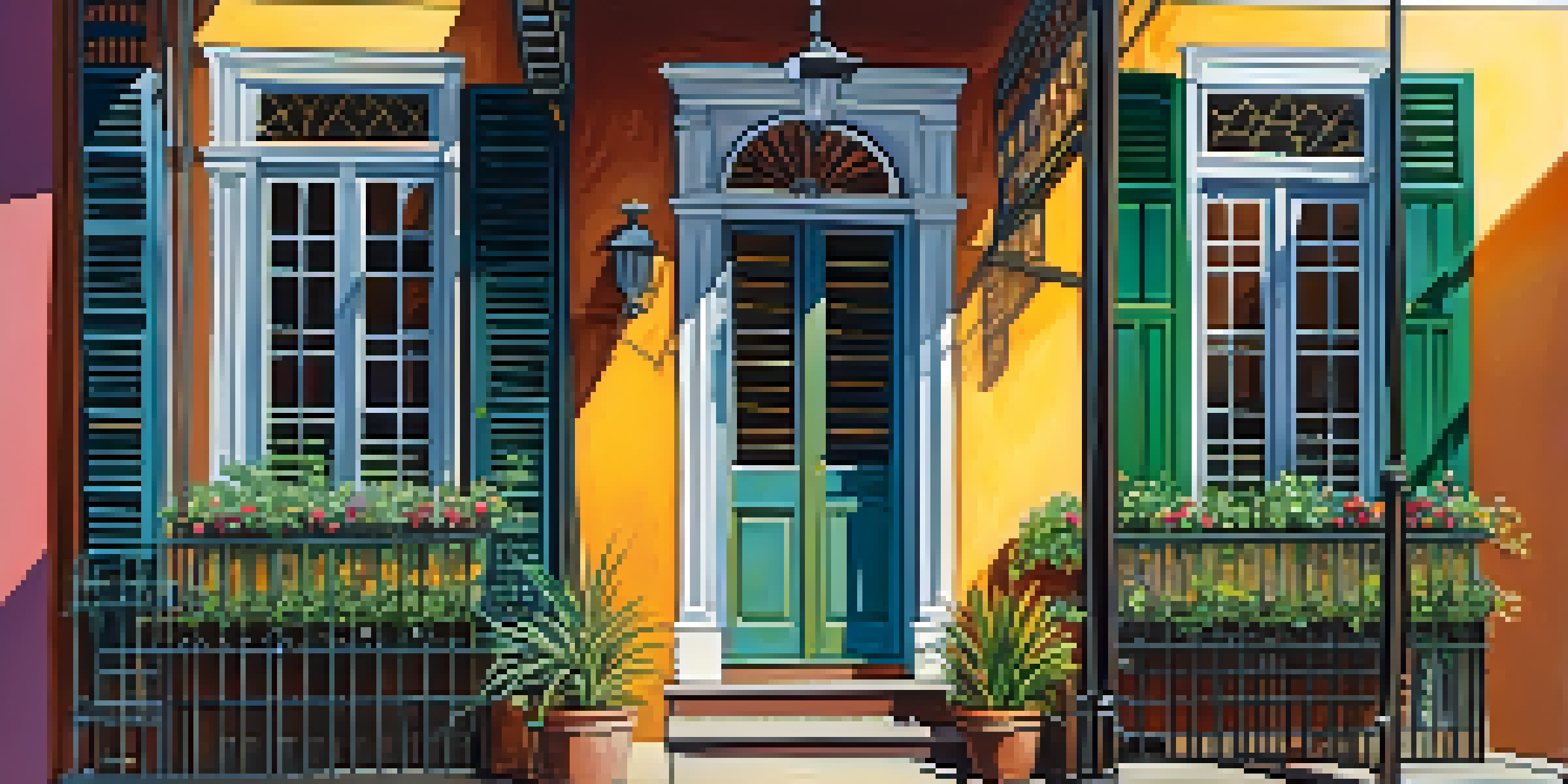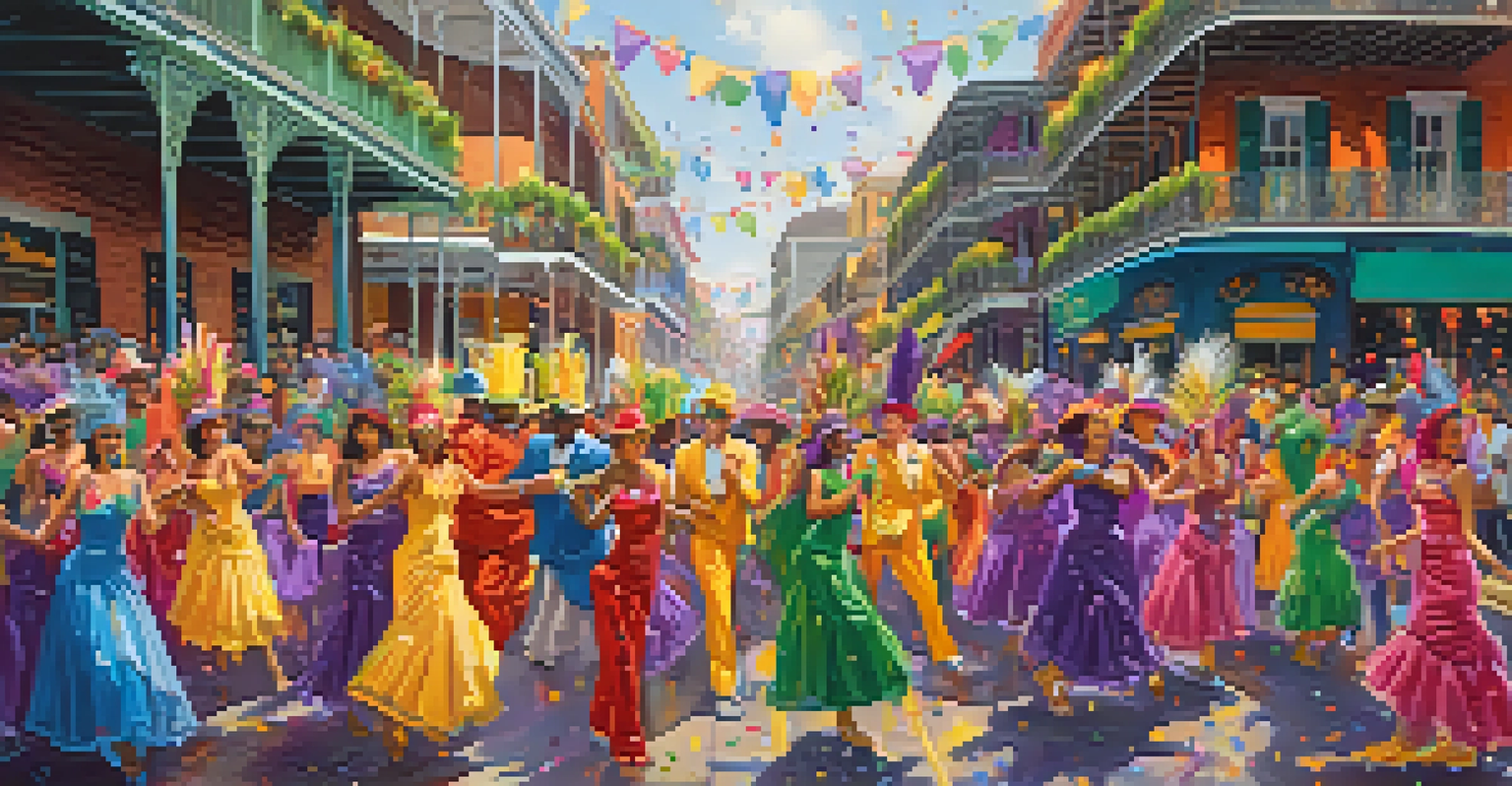The Blend of French and Spanish Styles in New Orleans

A Brief History of New Orleans' Cultural Roots
New Orleans, often called the 'Big Easy,' has a rich history that reflects a unique blend of cultures. Founded in 1718 by the French, the city was later ceded to Spain in 1763, creating a cultural tapestry that is still evident today. This historical backdrop laid the groundwork for a vibrant community where French and Spanish customs intertwined.
New Orleans is a city that has a rhythm and a soul, a place where the past is alive within the present.
The French influence is particularly visible in the architecture, cuisine, and language, while Spanish traditions enriched local celebrations and social customs. This combination of influences has given New Orleans its distinct identity, making it a fascinating destination for history buffs and cultural enthusiasts alike. The city’s evolution is a story of adaptation, resilience, and creativity.
As we delve deeper into the fusion of these two cultures, we will explore how they have shaped various aspects of life in New Orleans, from its iconic architecture to its flavorful cuisine. Each element tells a story of its own, reflecting the unique heritage of this remarkable city.
Architectural Wonders: French and Spanish Influences
One of the most striking aspects of New Orleans is its architecture, which showcases the blend of French and Spanish styles. The iconic French Quarter, with its wrought-iron balconies and colorful façades, reflects French colonial design, while the Spanish colonial buildings feature red-tiled roofs and stucco walls. This architectural diversity creates a picturesque landscape that attracts visitors from around the world.

Walking through the streets of the French Quarter feels like stepping back in time, as you encounter buildings that have stood for centuries. The preservation of these structures is a testament to the city’s commitment to honoring its heritage. The blending of these styles also speaks to the adaptation and evolution of architectural practices in response to climate and culture.
Cultural Blend Shapes Identity
New Orleans' unique identity is a result of the rich interplay between French and Spanish cultures, influencing its architecture, cuisine, and festivals.
This architectural fusion not only enhances the beauty of the city but also serves as a physical representation of its complex history. It invites exploration and appreciation, making New Orleans a living museum where every corner reveals a new story about its past.
Culinary Delights: A Taste of Two Cultures
New Orleans is a food lover's paradise, and its cuisine is a perfect reflection of the city's French and Spanish influences. Dishes like gumbo and jambalaya showcase this blend, incorporating techniques and flavors from both cultures. For example, the use of spices and ingredients in these dishes often harkens back to Spanish culinary traditions, while the cooking methods may be influenced by French techniques.
The culture of New Orleans is a blend of so many influences; it’s a rich tapestry of life, history, and music.
The city is also famous for its pastries, particularly beignets, which are deeply rooted in French cuisine. On the other hand, tapas-style dining has found its way into the local food scene, bringing a taste of Spain to the table. This culinary fusion not only tantalizes taste buds but also tells a story of cultural exchange and adaptation.
Dining in New Orleans is more than just a meal; it’s an experience that celebrates the rich tapestry of its culinary heritage. Whether you're savoring a rich étouffée or indulging in a sweet flan, each bite reflects the harmonious blend of French and Spanish flavors.
Festivals: Celebrating Cultural Heritage
Festivals in New Orleans are vibrant expressions of the city’s cultural heritage, often showcasing the blend of French and Spanish traditions. Events like Mardi Gras, with its colorful parades and lively music, have roots in both cultures. This celebration of life and community is a testament to the city’s ability to unite diverse influences into a cohesive and joyous experience.
Spanish-inspired festivities, such as La Fiesta de la Virgen de Guadalupe, highlight the city’s religious and cultural ties to its past. These festivals not only attract locals but also draw visitors from around the globe, eager to partake in the revelry. The shared joy and camaraderie during these events exemplify the spirit of New Orleans.
Architectural Diversity
The city's architectural landscape features a stunning mix of French colonial and Spanish styles, creating a picturesque environment that tells stories of its past.
Through music, dance, and food, these festivals serve as a reminder of the city’s rich history and the ongoing celebration of its diverse cultural tapestry. They invite everyone to join in the festivities, fostering a sense of community and belonging.
Language: A Blend of French and Spanish Dialects
Language in New Orleans is another fascinating aspect of its cultural blend, with both French and Spanish influences shaping the local dialects. While English is the predominant language, you’ll often hear French phrases and expressions sprinkled throughout conversations. This linguistic diversity adds to the city’s charm and authenticity, making it a unique place to experience.
The presence of Louisiana Creole and Cajun French further highlights the melding of these cultures. These dialects, developed from a combination of French, Spanish, African, and Native American languages, reflect the city’s complex history and demographics. They serve as a reminder of the resilience and adaptability of the community.
Communication here is not just about words; it’s about storytelling, culture, and connection. The blend of languages enriches the community, fostering a sense of identity and belonging among its residents.
Art and Music: A Cultural Melting Pot
Art and music in New Orleans are vibrant reflections of its French and Spanish heritage, creating a cultural melting pot that captivates the senses. From jazz and blues to traditional Spanish flamenco, the city is alive with diverse sounds and rhythms. This musical fusion is not just entertainment; it tells the story of a community shaped by its past and present.
Art galleries and street performances often showcase the influence of both cultures, with artists drawing inspiration from their rich histories. The use of colors, forms, and themes in local art can often be traced back to French and Spanish traditions, creating a visual dialogue that resonates with residents and visitors alike. This artistic expression fosters a deeper understanding of the city’s unique identity.
Vibrant Festivals and Language
Festivals and the local dialects highlight the celebration of cultural heritage in New Orleans, showcasing the enduring influence of its diverse roots.
By immersing yourself in the local music and art scene, you gain insight into the soul of New Orleans. Each note and brushstroke carries the weight of history, celebrating the harmonious blend of cultures that defines this extraordinary city.
Conclusion: Embracing Cultural Diversity in New Orleans
New Orleans stands as a testament to the beauty of cultural diversity, with its French and Spanish influences creating a rich and vibrant tapestry. From the architecture and cuisine to festivals and language, every aspect of the city reflects this unique blend. It’s a place where history is alive, and the past continues to shape the present.
As you explore the city, take a moment to appreciate the layers of culture that define New Orleans. Each street corner, each dish, and each celebration tells a story that connects the past to the present. This cultural richness is what makes New Orleans not just a destination, but a living, breathing celebration of heritage.

In embracing its diverse roots, New Orleans invites everyone to partake in its unique narrative. Whether you're a local or a visitor, there’s always something new to discover and celebrate in this extraordinary city that thrives on the blend of French and Spanish styles.